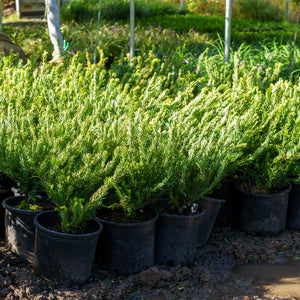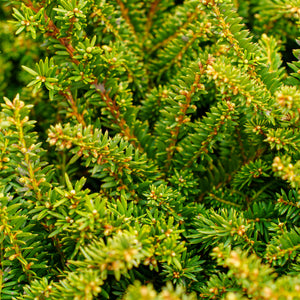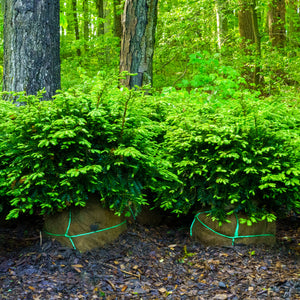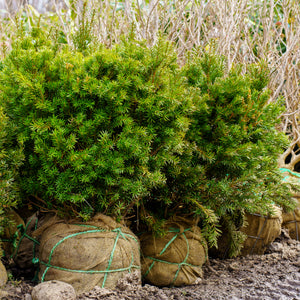The Yew Guide
Yews (Taxus spp.) are timeless, evergreen shrubs and trees valued for their dense foliage, year-round greenery, and remarkable adaptability. Whether used in formal hedges, foundation plantings, or shaded gardens, yews offer structure, longevity, and classic elegance. Their tolerance for pruning and shade makes them one of the most versatile evergreens in the landscape.
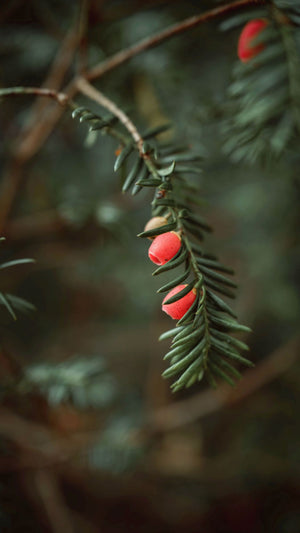
About
Yews are members of the Taxaceae family and are native to Europe, Asia, and North America. They have flat, needle-like foliage and produce bright red, berry-like arils that add winter interest. While slow-growing, they are extremely long-lived and adaptable.
There are several common species and hybrids in cultivation:
- Taxus baccata (English Yew): Upright and often used in formal topiary or hedging; includes narrow forms like 'Fastigiata' and spreading types like 'Repandens'.
- Taxus cuspidata (Japanese Yew): More cold-hardy and often used in northern climates. 'Bright Gold' is a golden-foliaged selection.
- Taxus x media (Hybrid Yew): A cross between Taxus baccata and Taxus cuspidata, combining hardiness with compact habit. Popular cultivars include:
Yews are dioecious, meaning male and female flowers occur on separate plants. Only female plants produce berries.
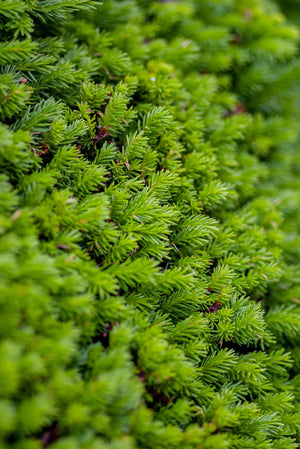
PLANTING
USDA Hardiness Zones: Most yew species and hybrids grow well in Zones 4–7. Some English yews may be less hardy in Zone 4.
Soil: Prefers well-drained, slightly acidic to neutral soil. Avoid overly wet or waterlogged conditions, which can cause root rot.
Sunlight: Yews are highly adaptable to sun or shade. Full sun encourages dense growth, while partial to full shade is tolerated with slightly slower growth.
Watering: Moderate. Water regularly during establishment. Mature plants are drought-tolerant but benefit from deep watering during prolonged dry spells.
Spacing: Spacing depends on the cultivar’s size and use. Plant hedge types 2–4 feet apart; low spreaders like 'Everlow' can be spaced closer.
Planting Time: Spring or early fall is ideal. Avoid planting during midsummer heat or hard winter frost.
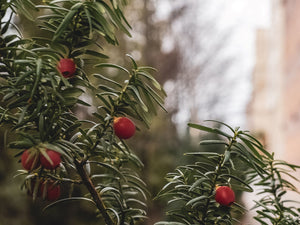
CARE
Watering: Keep soil evenly moist during the first year. Once established, yews require less frequent watering.
Fertilizing: Feed in early spring with a balanced slow-release fertilizer, especially in nutrient-poor soils.
Pruning: Yews tolerate heavy pruning and can be shaped into hedges, spheres, or columns. Prune in early to mid-spring before new growth begins. Light shaping can also be done in mid-summer.
Pests and Diseases: Generally pest-resistant. Root rot can occur in poorly drained soils. Needle blight or scale may appear but is uncommon in well-maintained specimens.
Mulching: Apply mulch around the base to retain moisture and suppress weeds. Keep mulch a few inches from the trunk.
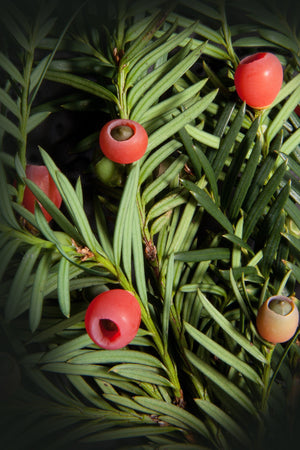
HOW TO USE
Formal Hedges and Screens: Upright cultivars like 'Hicksii' or 'Hatfield' create dense, evergreen privacy screens and formal hedges. They respond well to trimming.
Foundation Plantings: Compact selections like 'Densiformis' provide evergreen structure and year-round appeal at the base of buildings.
Shade Gardens: Yews thrive in part to full shade, making them ideal for under large trees or north-facing sites where other evergreens may struggle.
Topiary and Sculptural Use: English yew varieties like 'Fastigiata' are excellent for topiary or vertical accents.
Groundcovers and Slopes: Spreading forms like 'Everlow' and 'Emerald Spreader' are excellent for erosion control and low-maintenance groundcover.
Mixed Evergreen Borders: Pair with boxwood, holly, or azalea for texture contrast and winter interest.
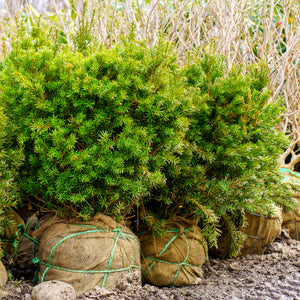
Common Questions
Are yew berries poisonous? Yes. All parts of the yew, especially the seeds within the red arils, are highly toxic to humans, dogs, cats, and livestock if ingested.
Do deer eat yews? Yews are unfortunately highly palatable to deer and may require protection in areas with heavy browsing pressure.
When to prune a yew? Major shaping and rejuvenation pruning should be done in early spring. Light trimming can be done again in mid-summer to maintain form.
Do rabbits eat yew? Yes, rabbits may feed on the bark and lower stems, especially in winter. Use physical barriers if damage is observed.
How to prune a yew? Use sharp shears to shape and thin the plant. Remove any dead or damaged branches. Yews can be cut back hard if needed and will typically regrow.
How to use yew? Use for hedging, screening, formal shapes, shade planting, or groundcover. Yew is extremely versatile and long-lived.
Do yews require full sun? Yews grow well in both sun and shade. Full sun encourages denser foliage, but part to full shade is also suitable.
Conclusion
Yews are the quintessential evergreen, offering a combination of structure, adaptability, and longevity that few plants can match. Whether clipped into formal hedges, grown as graceful columns, or spread across slopes, yews perform reliably in a wide range of conditions. With careful planting and pruning, Taxus species remain a cornerstone of classic and contemporary landscapes alike.
The Yew Collection
Sold Out
Sold Out
Sold Out

